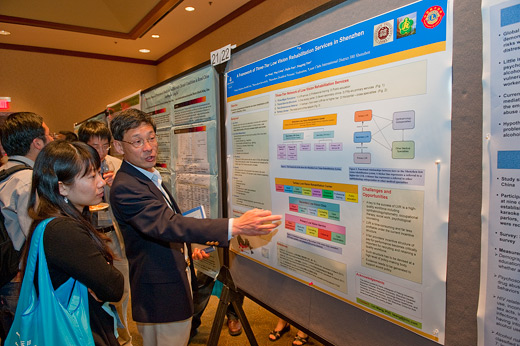Campus News
April 15, 2011
U.S., China have similar health reform issues

The three-day Westlake Forum III at the Emory Conference Center allowed participants to share ideas and discuss solutions for improving health care in both countries. Photo by Tony Benner.
By Holly Korschun
The United States has much in common with China when it comes to issues of health care delivery and health reform, notes Jeff Koplan, director of the Emory Global Health Institute.
This week those similarities were evident when more than 250 Chinese and U.S. health administrators and scholars from leading academic and government institutions gathered at Emory. The three-day Westlake Forum III at the Emory Conference Center allowed participants to share ideas and discuss solutions for improving health care in both countries.
"Healthcare Reform in China and the US: Similarities, Differences and Challenges," was the third conference in the Westlake series, and the first to be held in the United States. It was co-hosted by the Emory Global Health Institute, Zhejiang University School of Medicine and the China Medical Board.
"This was an incredible human partnership, bringing together two countries with very different governments and cultures, recognizing our common problems and desires for improved health of all our citizens, working together on difficult issues and exploring workable solutions," says Koplan.
Similar priorities
According to Shanlian Hu, a professor at Fudan University, China's health care reform priorities include expanded coverage, equal access, improved benefits, improved care delivery systems and containment of soaring medical costs. These are remarkably similar to priorities of the recent U.S. Patient Protection and Affordable Care Act.
Health care delivery in China is highly decentralized, with a tiered system of coverage for urban and rural residents, Hu explained. The government is committed to health care as a public good, however, with the goal of complete coverage by 2020. Although 90 percent of citizens are currently covered, cost and accessibility vary considerably.
Hospital stays are longer than in the United States, medical training is less rigorous, and access to high-quality care is limited. Like the U.S., China's public hospitals and providers struggle with the economic and quality issues generated by a "fee-for-service" reimbursement mechanism.
Yet health care costs in China are only 5.13 percent of the country's GDP, compared to 17 percent in the U.S.
William Roper, dean of the University of North Carolina School of Medicine and CEO of the UNC Health System, said health care in the United States is a "paradox of excess and deprivation," and Americans need to rethink their long-held assumptions.
Americans believe they have the best health care system in the world, yet we spend more on medical care than any other country. We are the only rich democracy in which a substantial portion of citizens lack care, nurses are in short supply, quality and safety are not as high as they should be, and incentives for physicians are skewed toward specialization and expensive technical procedures, Roper said.
Making reform effective
Political constraints and a lack of attention to international experience have resulted in a patchwork reform plan that offers thin coverage, with many remaining uninsured. Effective health care reform will require broad-based cooperation, and proposals must take cost control seriously, he emphasized.
Harvard Professor William Hsiao noted that China has made significant progress in health care reform over the past seven years. In 2003, 75 percent of Chinese citizens were uninsured, whereas today China offers coverage on some level to 90 percent, with out-of-pocket payments continuing to decline. Problems persist, however, in lack of well-trained physicians and equipment, distorted prices and profit motives of public hospitals and officials.
Ken Thorpe, professor and chair of health policy and management in Emory's Rollins School of Public Health, outlined the newly passed U.S. health reform law, which aims to expand and improve coverage, improve access to quality care, and control rising costs. Many of these improvements would likely be paid through Medicare reductions and increased taxes on higher income households.
The opening session of the conference on April 10 included a welcome and overview of Emory health sciences by Wright Caughman, interim executive vice president for health affairs and CEO of the Woodruff Health Sciences Center. Howard Koh, assistant secretary for health, U.S. Department of Health and Human Services, presented an overview of U.S. health care reform.
Other sessions in the three-day conference brought together Chinese and U.S. experts to discuss issues of professionalism, financing, integrated delivery systems, incentive structure, information technology, quality improvements and comparative effectiveness.
